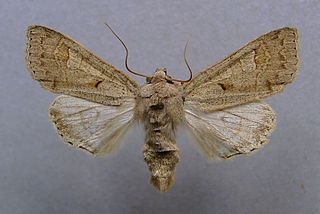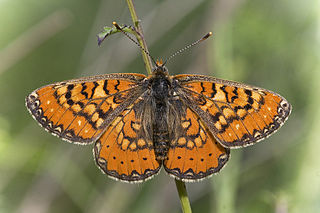
Marmots are large ground squirrels in the genus Marmota, with 15 species living in Asia, Europe, and North America. These herbivores are active during the summer, when they can often be found in groups, but are not seen during the winter, when they hibernate underground. They are the heaviest members of the squirrel family.

The marsh fritillary is a butterfly of the family Nymphalidae. Commonly distributed in the Palearctic region, the marsh fritillary's common name derives from one of its several habitats, marshland. The prolonged larval stage lasts for approximately seven to eight months and includes a period of hibernation over the winter. The larvae are dependent on the host food plant Succisa pratensis not only for feeding but also for hibernation, because silken webs are formed on the host plant as the gregarious larvae enter hibernation. Females lay eggs in batches on the host plant and are, like other batch-layers, selective about the location of oviposition because offspring survivorship levels for batch-layers are more tied to location selection than they are for single-egg layers.

The East Siberian taiga ecoregion, in the Taiga and boreal forests biome, is a very large biogeographic region in eastern Russia.

Eurybia sibirica, commonly known as the Siberian aster or arctic aster, is an herbaceous perennial native to north western North America and northern Eurasia. It is found largely in open areas of subarctic boreal forests, though it is also found in a wide variety of habitats in the region. It is similar in appearance to Eurybia merita, but their ranges overlap only near the border between the US and Canada, where E. sibirica is generally found at higher elevations.

The Asian ibex, also known using regionalized names as the Siberian ibex,Altai ibex, Central Asian ibex, Gobi ibex, Himalayan ibex, Mongolian ibex or Tian Shan ibex, is a polytypic species of ibex. It lives in central Asia, it is by far the most widely distributed species in the genus Capra and Asian ibex is listed as Near Threatened in view of the prevalence of threats, low densities in most areas and overall population decline, but available data are of insufficient reliability and area coverage. It has formerly been treated as a subspecies of the Alpine ibex, and whether it is a single species or a complex of distinct units that stand out as genetically differentiated at species level is still not entirely clear. It is the longest and heaviest member of the genus Capra, though its shoulder height is surpassed by the markhor.
The Gobi jerboa is a species of rodent in the family Dipodidae. It is found in China and Mongolia. Its natural habitats are temperate grassland and temperate desert.

Erebia is a Holarctic genus of brush-footed butterflies, family Nymphalidae. Most of the about 90–100 species are dark brown or black in color, with reddish-brown to orange or more rarely yellowish wing blotches or bands. These usually bear black spots within, which sometimes have white center spots.

Ammoconia caecimacula is a moth of the family Noctuidae. It is found in most of Europe, except southern Spain, Great Britain, Ireland and northern Fennoscandia. It is also present in Anatolia, western Turkestan and across the Palaearctic to Siberia. In the east the species is represented by subspecies transcaucasica and sibirica.

Erebia callias, the Colorado alpine, is a member of the Satyridae subfamily of the Nymphalidae butterflies. It is found in alpine areas of Wyoming and Colorado in the U.S. Rocky Mountains as well as various mountain ranges in eastern Asia.

Euphydryas desfontainii, the Spanish fritillary, is a species of butterfly in the family Nymphalidae. It is found in France, Portugal, Spain, Morocco and western Algeria in North Africa.
Athrips sibirica is a moth of the family Gelechiidae. It is found in Russia (Altai), Mongolia and China (Hebei). The habitat consists of steppes and forest-steppes in the mountains.

The Altai montane forest and forest steppe ecoregion covers patches of the subalpine forest belt on the Altai Mountains, crossing the border region where Russia, Kazakhstan, Mongolia and China meet. The region has high biodiversity, as it is located in transition zones between different ecoregions, altitudes, and climate zones. It is in the Palearctic realm, with a Cold semi-arid climate. It covers 35,199,998 km2 (13,590,795 sq mi).

Euphydryas intermedia synonym ichnea is a small butterfly found in the Palearctic that belongs to the browns family. It occurs up to 2200 m above sea level.

Euphydryas anicia, the anicia checkerspot, is a species in the family of butterflies known as Nymphalidae. It was first described by Edward Doubleday in 1847 and it is found in North America.
Epichloë sibirica is a haploid species in the fungal genus Epichloë.

Euphydryas orientalis is a small butterfly found in the Palearctic that belongs to the browns family.

Euphydryas asiatica is a small butterfly found in the Palearctic that belongs to the browns family.












